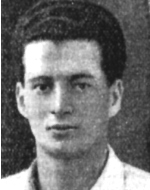Margalit, Emanuel
Son of Rachel and Nehemiah, was born on September 20, 1929 in Tel Aviv. He completed his elementary school with honors and received a scholarship to continue his studies at the Balfour Gymnasium. He was also one of the best students in the Gymnasium, with a conscience and an attitude of holiness toward studies and respect for teachers. He loved music very much, learned to play the violin, gave private lessons, and even found time to help his mother with housework. He was also a good athlete. During his summer vacations, he worked with his friends in the farms and treated his work with a sense of duty and devotion. Emanuel tried to instill in his colleagues in the labor camps the sense of duty, discipline, and morality. In a healthy Jewish-Jewish perspective, he commented on social and political phenomena in the life of the people and the country, and on the events in his limited circle. When the Jewish Brigade left for the front, he expressed sorrow in his diary for his young age, which prevented him from going with the adults to avenge his people. From the age of 14 he was a member of the Haganah, completed a course for instructors and excelled in training. He also participated in the struggle against the British as part of the Hagana youth. Following the UN General Assembly resolution of November 29, 1947, the division of the country into two states and the outbreak of the War of Independence, he volunteered for service in the “Kiryati” Brigade and was sent to positions for the defense of Tel Aviv. He took a more senior officer course, but when he finished and was about to be sent for training, he refused to take the job of training the home front because he saw it as a kind of “shirking” and demanded a combat role. On January 1, 1948 he went to work in Selma, where he volunteered and moved from a ward to a break-in ward. At the time of Operation David, the big operation in Abu Kabir fell, in the hope of saving a wounded friend, on the 13th of Adar I 5708 (February 13, 1948), and was brought to rest in the Nachlat Yitzhak military cemetery.
